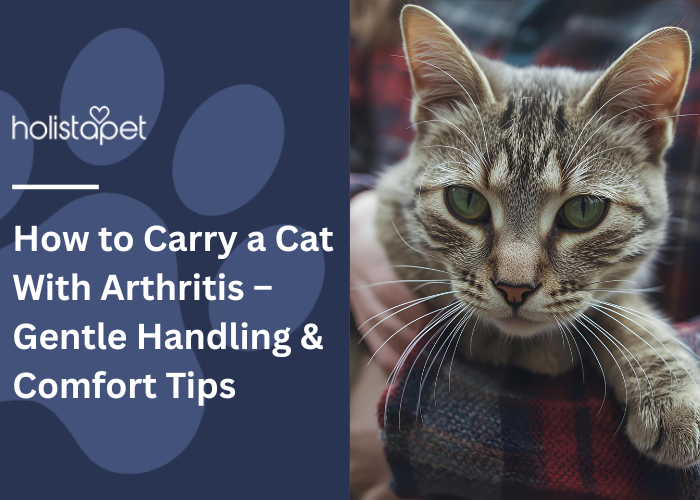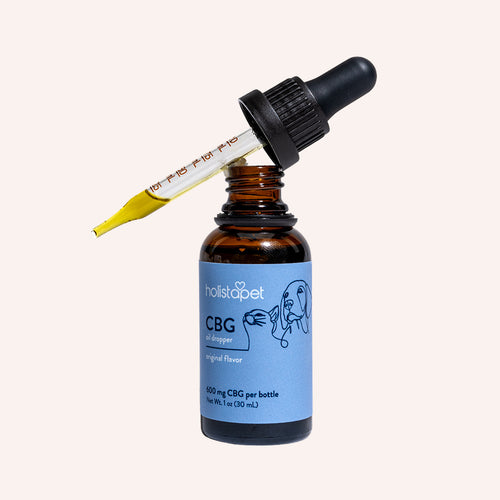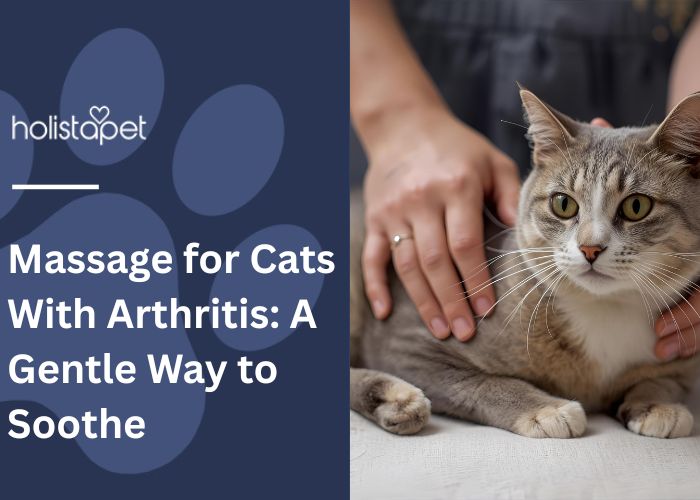You scoop up your cat like always, but this time, they let out a soft meow that sounds more like discomfort than surprise. You pause, wondering how to carry a cat with arthritis without making things worse. Arthritis causes sore joints and stiff movements, so even light cuddles can bring aches.
This doesn’t mean you can’t hold your furry buddy anymore. With a few gentle handling habits and smart comfort tricks, you can keep them calm, supported, and pain-free in your arms. This guide shows you exactly how, so read on.
Understanding Arthritis in Cats
Arthritis occurs when the smooth cartilage inside your cat’s joints wears down, leading to swelling and stiffness. As your cat ages, this wear and tear can make every stretch or jump harder. Learning how to handle a cat with arthritis starts with understanding how it affects their mobility. Arthritic cats often move slowly, hesitate before jumping, or skip playtime altogether.
You might notice subtle signs of arthritis—less grooming, extra naps, or a limp after resting. Some cats hide or become irritable when touched around sore joints. Watch for stiffness, reduced flexibility, or trouble using the litter box. If you spot these signs, schedule a vet visit. A proper exam confirms feline arthritis and helps guide your next steps for care.
Why Proper Handling Matters for Arthritic Cats

Gentle handling matters because sore joints and weak muscles make movement harder for cats living with arthritis or degenerative joint disease, especially aging cats. Rough lifts or awkward grips can strain those areas and cause more discomfort. Knowing how to hold a cat with arthritis prevents sudden joint pain and builds your cat’s trust.
Never lift your cat by the front legs or belly. Move slowly and support the chest and hindquarters evenly. This keeps weight balanced and reduces stress on tender joints. Soft bedding, ramps, and padded carriers make daily movement easier and safer. Careful handling protects comfort and strengthens your bond.
Preparing to Lift and Carry an Arthritic Cat
Before lifting your arthritic cat, create a calm space with soft lighting and minimal noise. A peaceful setting keeps them relaxed, reduces anxiety, and supports gentle pain relief. Use a towel, blanket, or cushion for extra support under their body. This steadies them and prevents slipping. Overweight or inactive cats can also develop arthritis, so gentle handling is always best.
Check your cat’s mood first. If they seem tense, wait until they’re calm. Speak softly, move slowly, and avoid sudden motions. Loud sounds or quick grabs can startle them. After carrying, place them in a cozy, secure resting spot.
Simple Guide: How to Hold a Cat With Arthritis
Holding an arthritic cat takes care and balance. Always support their chest and hindquarters to spread their weight evenly. Keep their spine level to avoid putting extra strain on sore joints.
Hold your cat close to your body for warmth and security. Stay calm, move slowly, and speak softly. These small adjustments help your cat feel safe, supported, and comfortable in your arms.
Supporting Both the Chest and Hindquarters
Place one hand under your cat’s chest, just behind the front legs. Slide your other hand under the hindquarters to share the load. Keep their body level as you lift so the weight stays even. Holding close to your chest adds warmth and helps them feel secure.
Avoid lifting by the underarms, legs, or scruff, as those grips cause irritation. Move slowly and speak softly as you carry. Practice short lifts near the floor until you both feel confident. This method protects sore joints, reduces discomfort, and builds trust during pickup.
Keeping the Spine Level and Steady
Keeping your cat’s spine straight is key to reducing pressure on sore joints. Support both the chest and hindquarters evenly with your hands so the body stays balanced. As you lift, keep your cat parallel to the ground to prevent twisting or bending.
Avoid letting their back sag or arch while you hold them. Move slowly and with control to maintain stability. A steady spine helps reduce discomfort and keeps your cat relaxed and secure during every lift.
Holding Your Cat Close for Security and Comfort
Hold your cat close to your chest so they feel safe and supported. Keep one hand under the chest and the other under the hindquarters for balance. A steady grip helps them relax and prevents slipping.
Avoid squeezing too tightly. Gentle pressure works best. The warmth from your body can soothe stiff joints and ease nervous behavior. Speak softly or keep eye contact to reassure them. Stay still, move slowly, and keep your movements smooth and steady.
What Not to Do When Handling an Arthritic Cat
Even with the best intentions, certain actions can make your arthritic cat uncomfortable. Avoid these common mistakes to keep them safe and pain-free.
-
Avoid Dangling Limbs or Unsupported Weight – Letting your cat’s legs or hips dangle puts extra strain on sore joints. Always support the chest and hindquarters evenly to prevent discomfort. Balanced support keeps your cat relaxed and secure.
-
Avoid Jerky or Sudden Movements – Quick or rough handling can startle your cat and cause muscle tension or arthritis pain. Move slowly and steadily to reduce stress on painful joints. Smooth movements make every lift easier.
-
Never Force a Cat Into Uncomfortable Positions – Forcing your cat to bend or twist can hurt stiff joints and cause fear. Let them adjust naturally and follow their lead. Gentle, patient handling helps build trust and keeps your arthritic cat comfortable and confident in your care.
How to Transport a Cat With Arthritis Safely

Traveling with a cat who has achy joints takes extra care. Pet owners should plan ahead to keep their cat relaxed and pain-free during the ride. You can’t just scoop them up and go anymore.
When learning how to transport a cat with arthritis, comfort and support matter most. The right setup keeps your furry friend calm, secure, and comfortable throughout the trip.
-
Choosing the Right Carrier (Soft Padding, Low Entry): Pick a carrier with a wide door and a soft, padded base. A low entry makes it easy for your cat to step in without jumping or stretching sore joints.
-
Making Car Travel Easier for Senior Cats: Keep the car quiet and steady. Place the carrier on a flat surface and add comfort aids, like Holistapet’s CBD for cats, to help reduce stress and stiffness.
-
When to Use Ramps or Carriers Instead of Lifting: Use ramps or sturdy carriers for movement instead of lifting directly. It helps protect your cat’s joints and keeps them feeling safe.
How to Promote Comfort in Arthritic Cats

Your cat deserves comfort, even with stiff joints slowing them down. Promoting ease starts with small, thoughtful changes at home. Gentle exercise and joint-friendly play help keep their body flexible.
Soft, supportive bedding gives sore joints a break. Easy-access furniture makes moving around less painful. You can also explore natural remedies, like CBD or massages, for joint support to help your cat feel more relaxed, mobile, and happy every day.
Gentle Exercise and Joint-Friendly Play
Light activity helps your arthritic cat stay flexible and comfortable. Gentle movement improves blood flow and keeps joints lubricated. Short play sessions on soft surfaces work best. Try slow wand toys or easy reach-and-swipe games. Avoid any that require jumping.
Avoid rough play or high jumps that strain sore joints. Keep sessions short but regular to prevent stiffness. Watch your cat’s reactions and stop if discomfort appears. Gentle play eases stress and keeps your cat’s mood bright and positive.
Soft, Supportive Bedding and Easy-Access Furniture
Comfort starts where your cat rests. Soft, cushioned, or orthopedic bedding helps ease pressure on sore joints and muscles. Warmth and padding soothe stiffness and promote deeper, more restful sleep.
Keep furniture low or add ramps so your cat can reach favorite spots without jumping or straining. Place beds in quiet, cozy areas away from drafts. Use non-slip mats or carpeted steps for safer movement. Over time, these small changes can lift your cat’s mood and improve daily mobility.
Natural Remedies for Joint Support
Cat owners can explore natural remedies to help their arthritic cats feel more comfortable. Simple, consistent care can go a long way toward supporting joint health and mobility.
-
Omega-3 Fatty Acids for Swelling – Omega-3s help reduce joint puffiness and tenderness. They can also improve flexibility and comfort in older cats. These fatty acids support healthy cartilage and overall mobility.
-
Glucosamine and Chondroitin for Joint Health – These compounds help maintain smooth joint movement. They may also protect cartilage from further wear and support flexibility. Many cats respond well to these gentle, long-term additions to their wellness routine.
-
CBD for Comfort and Calm – CBD may help soothe sore joints and muscle aches while promoting calmness. Holistapet’s CBD products for cats stand out because they use natural ingredients and hemp seed oil rich in Omega-3 and 6. They’re non-GMO, vegan, and free of harsh additives or preservatives. This combination offers soothing, plant-based comfort that cats can truly benefit from.
Additional Safe Handling Alternatives
There are other simple ways to make handling easier for your arthritic cat. Ramps and steps reduce the need for lifting and help your cat reach favorite spots safely. These tools protect sore joints and give your cat more independence.
Set up safe, easy-to-access resting spots, too. Choose soft, low surfaces your cat can climb onto without strain. Add non-slip mats to prevent sliding. With these small changes, you’ll keep your cat comfortable, confident, and moving with less effort each day.
When to See a Veterinarian for Arthritic Cats
Most cats with arthritis can live comfortably with good home care, but some obvious signs mean it’s time for a vet visit. Since some cat breeds are more prone to joint issues, regular checkups are especially important.
If your cat’s limp worsens, they cry in discomfort, refuse to move, or lose their appetite, contact your vet right away. Checkups help track joint health and the progressive disease over time. A vet can adjust the treatment plan or suggest new options like physical therapy or cold laser sessions to improve comfort and mobility.
Untreated arthritis can cause stiffness and chronic pain. Note behavior changes and share them during appointments. Professional care keeps your cat comfortable, mobile, and happy longer.
FAQs – Carrying and Handling Cats With Arthritis
How do I know if my cat is in too much pain to be picked up?
Watch for crying, flinching, or trying to get away. If your cat resists touch, limps more, or hides afterward, they’re likely uncomfortable. Stop lifting and schedule a vet visit for guidance.
Should I avoid carrying my cat altogether?
You don’t have to stop completely. Lift with support under the chest and hindquarters. Move slowly and keep their body level. If carrying still causes distress, use ramps or padded carriers for comfort.
Is a carrier better than carrying them in my arms?
A soft, padded carrier often feels safer for arthritic cats. It prevents twisting or sudden strain on sore joints. Keep the inside cozy with a blanket, and use smooth movements when placing your cat inside.
Can CBD really help with joint stiffness in cats?
Yes, CBD may ease soreness and support calm behavior. Holistapet’s CBD products use hemp seed oil with Omega-3 and 6. They’re natural, vegan, and gentle on your cat’s system for daily comfort and mobility.
Final Thoughts – Keeping Your Arthritic Cat Comfortable and Safe
Caring for a cat with arthritis takes patience, gentle handling, and simple home adjustments. Always lift with full support and move slowly to protect sore joints. Pair careful carrying with comfort aids like soft bedding, ramps, and vet-approved pain medications when needed.
For extra joint support, Holistapet’s CBD products provide natural, plant-based relief with hemp seed oil rich in Omega-3 and 6. They’re vegan, non-GMO, and safe for daily use. With consistency and care, you’ll keep your cat comfortable, confident, and happy through every stage of life.


 CBD Oil for Cats - Fast Acting
CBD Oil for Cats - Fast Acting
 CBD Cat Treats - Easy Dose
CBD Cat Treats - Easy Dose
 CBD Calming Chews for Cats - Highly Rated
CBD Calming Chews for Cats - Highly Rated
 CBG Oil for Dogs and Cats - Loved by Thousands
CBG Oil for Dogs and Cats - Loved by Thousands





Leave a comment
All comments are moderated before being published.
This site is protected by hCaptcha and the hCaptcha Privacy Policy and Terms of Service apply.